 W
WThe order Peramelemorphia includes the bandicoots and bilbies; it equates approximately to the mainstream of marsupial omnivores. All members of the order are endemic to the twin land masses of Australia-New Guinea and most have the characteristic bandicoot shape: a plump, arch-backed body with a long, delicately tapering snout, very large upright ears, relatively long, thin legs, and a thin tail. Their size varies from about 140 grams up to 4 kilograms, but most species are about one kilogram, or the weight of a half-grown kitten.
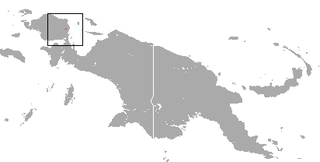 W
WThe Arfak pygmy bandicoot is a species of marsupial in the family Peramelidae. It is endemic to the Arfak mountains in the Vogelkop Peninsula of West Papua, in Indonesia. Its natural habitat is subtropical or tropical moist montane forests. The population is unknown and threats may be human expansion and hunting but it is protected by Arfak Reserve.
 W
WBandicoots are a group of more than 20 species of small to medium-sized, terrestrial marsupial omnivores in the order Peramelemorphia. They are endemic to the Australia–New Guinea region, including the Bismarck Archipelago and, marginally, in Indonesia (Seram).
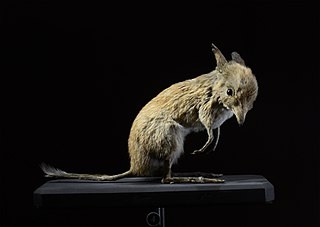 W
WChaeropus, known as the pig-footed bandicoots, is a genus of small mammals that became extinct during the twentieth century. The species were unique marsupials, of the order Peramelemorphia, that had unusually thin legs yet were able to move rapidly. There are two recognised species of these marsupials, which inhabited dense vegetation on the arid and semi-arid plains of Australia. The distribution range of the genus was later reduced to an inland desert region, where it was last recorded in the 1950s; it is now presumed to be extinct.
 W
WClara's echymipera, or Clara's spiny bandicoot or white-lipped bandicoot, is a species of marsupial in the family Peramelidae. It is found in West Papua, Indonesia and Papua New Guinea. Its natural habitat is subtropical or tropical dry forests. It is threatened by habitat loss.
 W
WThe common echymipera, or common spiny bandicoot, is a bandicoot. It is long-snouted even by bandicoot standards. The upper parts are a coarse reddish brown, flecked with spiny buff and black hairs. The tail is short and almost hairless. Length varies between 300 and 400 mm, with the tail accounting for an additional 80 to 100 mm; weight is from 600 to 2000 g.
 W
WDavid's echymipera, or David's spiny bandicoot, is a species of marsupial in the family Peramelidae. It is found on the island of Kiriwina, in the Trobriand Islands of Papua New Guinea, and may be present on other nearby islands also.
 W
WThe desert bandicoot is an extinct bandicoot of the arid country in the centre of Australia.
 W
WThe Easter Bilby is an Australian alternative to the Easter Bunny.
 W
WThe eastern barred bandicoot is a nocturnal, rabbit-sized marsupial endemic to southeastern Australia, being native to the island of Tasmania and mainland Victoria. It is one of three surviving bandicoot species in the genus Perameles. It is distinguishable from its partially-sympatric congener – the long-nosed bandicoot – via three or four dark horizontal bars found on its rump. It is the only species of bandicoot found on Tasmania, where it is relatively abundant. The mainland population in Victoria is struggling and is subject to ongoing conservation endeavors. This species is the basis for the popular video game character Crash Bandicoot.
 W
WThe giant bandicoot is a species of marsupial in the family Peramelidae endemic to Papua New Guinea. Its natural habitat is subtropical or tropical dry forests.
 W
WThe golden bandicoot is a short-nosed bandicoot found in northern Australia. It is the smallest of its genus.
 W
WThe greater bilby, often referred to simply as the bilby since the lesser bilby became extinct in the 1950s, is an Australian species of nocturnal omnivorous animal in the order Peramelemorphia. Other vernacular names include dalgyte, pinkie, or rabbit-eared bandicoot. Greater bilbies live in arid parts of northwestern and central Australia. Their range and population is in decline.
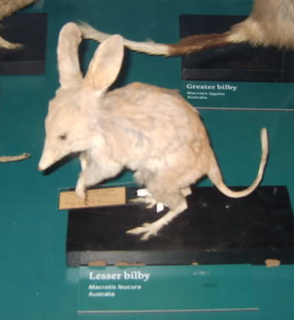 W
WThe lesser bilby, also known as the yallara, the lesser rabbit-eared bandicoot or the white-tailed rabbit-eared bandicoot, was a rabbit-like marsupial. The species was first described by Oldfield Thomas as Peregale leucura in 1887 from a single specimen from a collection of mammals of the British Museum. Reaching the size of a young rabbit, this species lived in the deserts of Central Australia. Since the 1950s–1960s, it has been believed to be extinct.
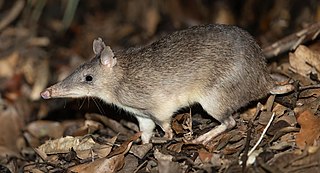 W
WThe long-nosed bandicoot is a species of bandicoot found in eastern Australia, from north Queensland along the east coast to Victoria. Around 40 centimetres (16 in) long, it is sandy- or grey-brown with a long snouty nose. Omnivorous, it forages for invertebrates, fungi and plants at night.
 W
WThe long-nosed echymipera, or long-nosed spiny bandicoot, is a species of marsupial in the family Peramelidae. It is found in Australia, Indonesia, and Papua New Guinea. Its natural habitat is subtropical or tropical dry forests.
 W
WMacrotis is a genus of desert-dwelling marsupial omnivores known as bilbies or rabbit-bandicoots; they are members of the order Peramelemorphia. At the time of European colonisation of Australia, there were two species. The lesser bilby became extinct in the 1950s; the greater bilby survives but remains endangered. It is currently listed as a vulnerable species. It is on average 55 cm (22 in) long, excluding the tail, which is usually around 29 cm (11 in) long. Its fur is usually grey or white, it has a long pointy nose and very long ears, hence earning its nick-name, the rabbit-eared bandicoot.
 W
WMenzies' echymipera, or Menzies' spiny bandicoot or Fly River bandicoot, is a species of marsupial in the family Peramelidae. It is endemic to Papua New Guinea.
 W
WThe mouse bandicoot is a species of marsupial in the family Peramelidae. It is endemic to West Papua, Indonesia. Its natural habitat is subtropical or tropical dry forests.
 W
WThe New Guinean mouse bandicoots or striped bandicoots are members of the order Peramelemorphia. In addition to the named species, there are two currently undescribed members of this genus.
 W
WThe northern brown bandicoot, a marsupial species, is a bandicoot found only on the northern and eastern coasts of Australia and nearby islands, mainly Papua New Guinea. It is not, however, found far inland.
 W
WThe northern pig-footed bandicoot was a small species of extinct herbivorous Australian marsupial in the genus Chaeropus, the pig-footed bandicoots. It has been believed to be extinct since the mid-20th century; the last confirmed observation was a specimen collected near Alice Springs in 1901, but reports from local Aborigines indicate that it may have survived in the Gibson and Great Sandy Deserts as late as the 1950s.
 W
WThe Papuan bandicoot is a species of marsupial in the family Peramelidae. It is endemic to Papua New Guinea. Its natural habitat is subtropical or tropical dry forests. M. papuensis is a small bandicoot with a soft coat with a clear back, upper torso and face stripes. Its head to body length is 175–205 mm; tail length 142–158 mm; the hind foot length is from 43 to 47.1 mm; the ear length 25 to 28 mm and it weighs 145-184 g.
 W
WPerameles is a genus of marsupials of the order Peramelemorphia.
 W
WThe marsupial family Peramelidae contains all of the extant bandicoots. They are found throughout Australia and New Guinea, with at least some species living in every available habitat, from rainforest to desert. Four fossil peramelids are described. One known extinct species of bandicoot, the pig-footed bandicoot, was so different from the other species, it was recently moved into its own family.
 W
WRaffray's bandicoot is a species of marsupial in the family Peroryctidae. It is found in Indonesia and Papua New Guinea. Its natural habitat is subtropical or tropical dry forests.
 W
WThe Seram bandicoot, also known as the Seram Island long-nosed bandicoot, is a member of the order Peramelemorphia that is endemic to the island of Seram in Indonesia. It is the only species in the genus Rhynchomeles.
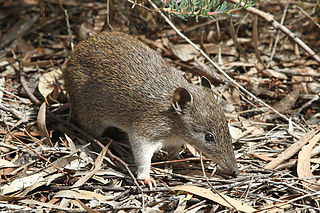 W
WThe short-nosed bandicoots are members of the order Peramelemorphia. These marsupials can be found across Australia, although their distribution can be patchy. Genetic evidence suggests that short-nosed bandicoots diverged from the related long-nosed species around eight million years ago, during the Miocene epoch, and underwent a rapid diversification around three million years ago, during the late Pliocene.
 W
WThe southern brown bandicoot is a short-nosed bandicoot, a type of marsupial, found mostly in southern Australia. It is also known as the quenda in South Western Australia.
 W
WThe southern pig-footed bandicoot – Chaeropus ecaudatus – was a small species of herbivorous marsupial in the genus Chaeropus, the pig-footed bandicoots.
 W
WThe striped bandicoot is a species of marsupial in the family Peramelidae. It is found in West Papua, Indonesia and Papua New Guinea. Its natural habitat is subtropical or tropical dry forests. The Striped bandicoot is a host of the Acanthocephalan intestinal parasite Australiformis semoni.
 W
WThe Western barred bandicoot, also known as the Marl, is a small species of bandicoot found in Australia.